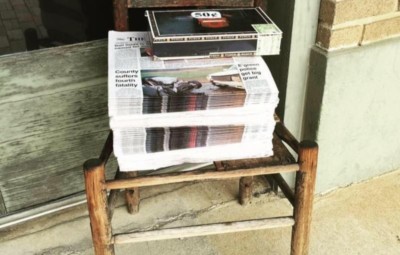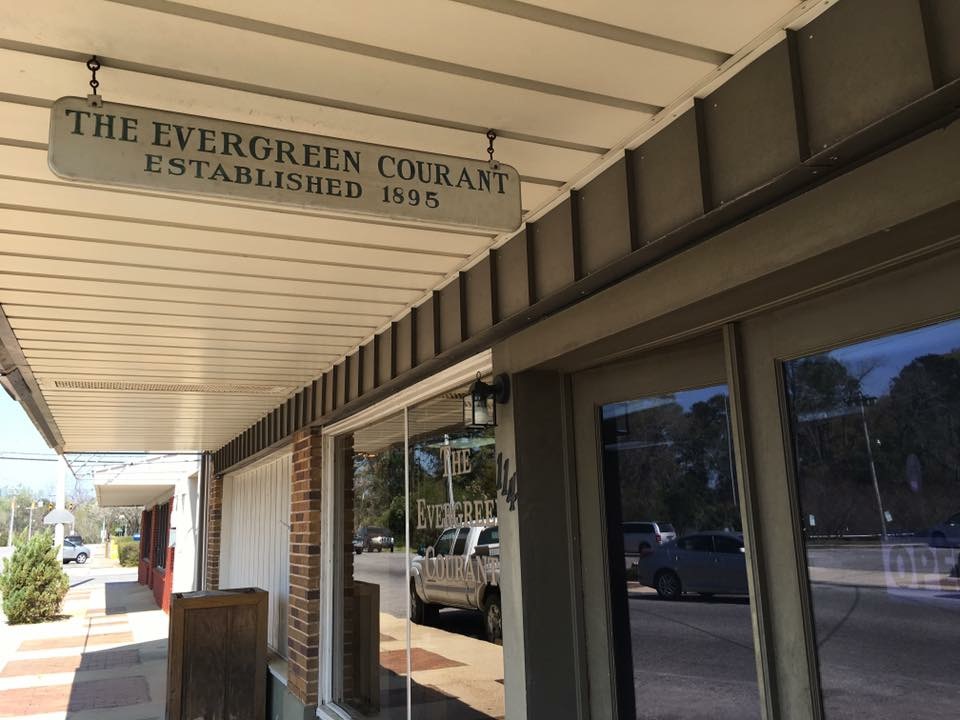Sign up for The Media Today, CJR’s daily newsletter.
For almost a century, a single wooden chair has been sitting on the aptly named Rural Street in Evergreen, Alabama. Nobody knows exactly how long “the chair,” as it’s simply and lovingly called, has been there. Most say since at least World War II, or even the 1920s—as long as the Bozeman family has owned it. It’s old, and has lost a few slats over the years, but the oak skeleton is still strong enough to support a stack of The Evergreen Courant every week. And on top of those newspapers sits a small black cigar box with a worn label reading “50¢.” With no online presence to speak of, the weekly newspaper relies on this honor system to sell copies—though most of its revenue comes from a pool of dedicated subscribers.
Robert Gaston Bozeman III is the third-generation owner and publisher of the Courant. His grandfather, Robert Gaston Bozeman, Sr., moved to Evergreen in the 1920s and became the Courant’s publisher after its original owner died. Bozeman isn’t sure, but he guesses the newspaper, which was established in 1895, officially switched hands in 1925. Bozeman’s grandfather ran the Courant until 1956, at which time his father, Robert Gaston Bozeman, Jr., became the owner. Bozeman, Jr. died in 1991, leaving Bozeman III to carry on the Courant’s legacy.

The famous chair. Photo credit: Ed Williams.
Back when Bozeman, Sr. was at the helm, Courant readers would wait outside the newspaper’s office for the latest issue, which was done in-house on a letterpress. “People would wait literally on sidewalk to get their paper,” Bozeman says, and sometimes they were so impatient they’d step inside and grab papers as they were being printed. Bozeman, Sr. didn’t like the disruption, so he grabbed a chair, stuck it outside, and rested the newly printed papers on it, topped with one of the several cigar boxes that littered the newsroom.
The only difference today is a 40 cent price increase, and 25 miles. Bozeman drives 30 minutes to the city of Monroeville where the Courant is now printed. He puts a stack of papers on the chair when he gets back. A hundred or so people swing by in the first hour-and-a-half, Bozeman says. The cigar box usually collects between $20 and $25 on Wednesday, $10 to $15 on Thursday, and a few more dollars on Friday. Of course, The Evergreen Courant doesn’t solely rely on its chair-and-cigar-box business model to stay afloat. Like most community newspapers, it’s heavily dependent on a loyal base of subscribers—3,600 at the moment. The Courant serves the whole of Conecuh County, which has a population of 13,228 according to the 2010 US Census. Evergreen is the county’s largest city, with just under 4,000 residents.
ICYMI: The story of a journalist who became a killer
The cigar box has been stolen only three times in its history. His grandfather caught the first guy, sometime in the 1960s, after seeing him swipe the box from the newsroom window. Bozeman himself once had to chase someone down the street. But most of the time, people don’t mess with it. “They know it’s a tradition,” Bozeman says. The chair may be the same one from his grandfather’s tenure, but they’ve gone through dozens of cigar boxes over the years due to wear and tear. “That chair ought to wind up in the Smithsonian or Newseum one day, it’s such an icon,” Ed Williams, retired Auburn University journalism professor and native of Conecuh County, says.
The chair is not Evergreen’s only claim to fame. Since 1973, it’s been dubbed the Collard Green Capital of Alabama. And just last June, the State Senate officially designated Evergreen the Bigfoot Capital of Alabama. The Courant’s ace reporter and managing editor, Lee Peacock, often writes about sightings of the legendary creature in Conecuh County; he even judged a “Bigfoot Calling Contest” in Evergreen this March. And Conecuh Sausage is iconic among Alabama breakfast enthusiasts. Its hickory-smoked links have been a staple of Conecuh County cupboards since 1947, and they’ve since made their way into restaurants and supermarkets across the southeastern part of the United States.
The chair does more than just sell papers. “Where the newspaper sits, everyone inside can see outside when people stop by,” Williams says. “It facilitates an interaction you don’t see at most newspapers.” It’s not unusual for Williams to pop inside the office before or after grabbing his paper. It’s a small room, maybe 10 by 30 feet, with a few desks scattered about for the paper’s handful of employees—six including Bozeman. “A person’s name is only in paper two times, when they’re born and when they die,” Williams says. “That’s true with large dailies, but people’s names appear in the community newspaper all the time.”
Because of this close and stable relationship, the financial state of community newspapers is often in a better place than its metropolitan counterparts, according to a study from the Tow Center for Digital Innovation. They publish “exclusive content not offered elsewhere,” write the study’s authors, Christopher Ali and Damian Radcliffe, and also tap into ultra-local advertising markets. “It’s a niche that community newspapers have that no other media source has,” says Felicia Mason, executive director of the Alabama Press Association. It doesn’t matter if the newspaper covers a town of 500 or 5,000. “If you wanna know [something], there’s nowhere else you’re gonna get that other than your local newspaper,” Mason says. The Courant brings in $300,000 in annual revenue. Sometimes they’re up, sometimes they’re down. But it’s been pretty consistent the last few years.
Lately, only one thing worries Bozeman about the news industry. “Tariffs are hurting printing as a whole,” he says. He’s referring to the tariffs imposed on Canadian newsprint by the US government earlier this year. Most publishers, including community newspapers like the Courant, rely on this cheap source of paper for their products. The new tariffs, though not yet permanent, are affecting newspapers of all shapes and sizes.
Because the Courant hasn’t made the move to digital, the tariffs are especially worrisome. A walk through the newspaper’s office is a bit like stepping into the past. Sure, they’ve traded hot type for computers, and plates for PDFs. But Bozeman can’t quite bring himself to part with the Linotype Model 14 sitting in the back of the building. When his grandfather purchased it in 1925, it was a state-of-the-art machine. Now it’s a museum-worthy relic, much like the chair and cigar box out front—and the Courant itself.
ICYMI: Dissatisfied with the national media’s frame, Appalachia finds its own voice
Has America ever needed a media defender more than now? Help us by joining CJR today.



